Book: A History of India Through 75 Objects
Author: Sudeshna Guha
Publisher: Hachette
Price: ₹1,299
If you enjoy books that engage with Indian history in compelling and inventive ways, Sudeshna Guha’s book would make a worthy addition to your bookshelf. Guha, a professor in the department of history and archaeology at Shiv Nadar University, is known for her research on museums, collections and curatorial practices. Through her compendium of 75 finely written essays about objects ranging from prehistoric to present-day India, she draws attention to the social, political and methodological issues that confront historical enquiry. Her over-arching argument is that the study of history helps us appreciate “the contingent and elusive nature of meaning” and dissuades us from falling into the trap of a mythical national past that affirms majoritarian fantasies.
The book opens with an essay on the Pallavaram Spear Head, a prehistoric stone tool discovered in 1863 by an Englishman named Robert Bruce Foote who worked for the Geological Survey of India. It ends with an essay on the Moveable Chalit Solar Pump, a machine used by marginalised tribal communities in Madhya Pradesh to irrigate farmlands.
Placed between these two are essays on the Dancing Girl, the Allahabad Pillar, the Yakshi of Didarganj, the Kharoshthi tablet, Samudragupta’s gold coin, the Sarnath Buddha, Pabuji’s Phad, the Baburnama, Chintz rumaal, a Chenchu flute, INS Vikrant, the poster of the film, Mother India, and books like Bhimayana and Munnu, among other objects. Guha writes about the histories of their creation, circulation and consumption: therefore, the essays are not only about materiality and crafts(wo)manship, they can also be read as social biographies. India’s Jadeite necklace, for instance, is discussed in relation to “the dismemberment of a shared cultural legacy (that) accompanied the official acts of creating a new national heritage for India and Pakistan.” It is horrifying to learn that when the historical collections of the Archaeological Survey of India were being divided in 1947, the jadeite necklace found inside a silver vessel in Mohenjodaro was “physically dismembered” to ensure that both nation states could have an equal share of the ‘spoils’ of Partition.
The book invites us to think about how material culture is deployed in the service of nation-making through processes of identification and acquisition, naming and custodianship. It pushes us to examine how meanings accumulate over time through legends, inscriptions, colonial records, oral histories, literature and political propaganda apart from the expertise of scholars who estimate or assign value based on criteria that might seem unintelligible to the people who have fashioned or unearthed some of those objects.
Apart from helpfully situating histories of production and excavation in contexts of empire and colonialism, Guha also alerts us to the issues of copyright and licensing that arise when replicas of antiquities, such as the Priest King and the Dancing Girl of the Indus Valley, are sold as souvenirs in museum shops or on e-commerce platforms.
At a time when the rhetoric of decolonisation is being employed to wipe out non-Hindu elements of Indian history, this book is a reminder of the fact that it is foolhardy — even dangerous — to think that our past can be divided into ancient, medieval and modern periods that neatly align with the so-called Hindu, Muslim and British periods. This false equivalence has implications beyond academic debates: it can endanger vulnerable minorities.
Guha acknowledges that any object-focused historical narrative — including hers — is bound to be “selective”. Acts of inclusion and reclamation are accompanied by acts of omission and erasure. Another scholar undertaking the task of assembling and interpreting 75 objects may have chosen an entirely different set. While analysing the ideological commitments that drive such practices of curation, it is worth reflecting on who gains and who loses, whether the status quo is reinforced or challenged.











